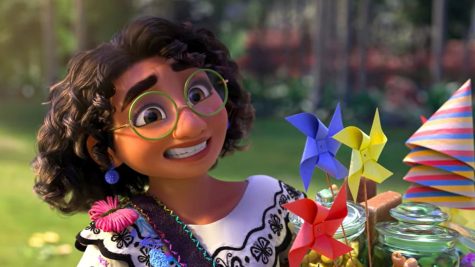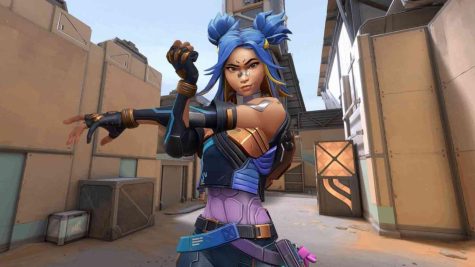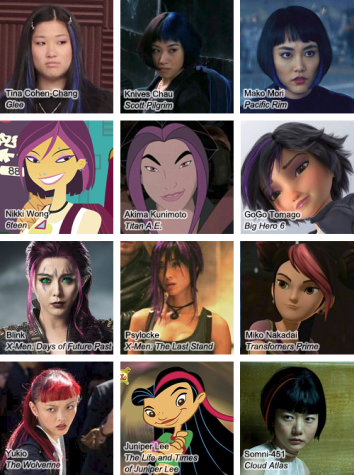Developments in Representation: Encanto & Valorant
A look into how Encanto and Valorant have incorporated racial representation
From Disney’s Encanto to the video game Valorant, racial diversity and representation have established themselves as significant and necessary aspects of media. A&E writers explore how Encanto accurately represents Latino characters with both the animation and writing, and how Riot Games’ addition of a Filipina character in Valorant is both a sign of progress and room for improvement.
Encanto: Doing Representation the Right Way
By Isabella Canales

For so long, people of color have been the brunt of the joke, playing the comedic relief who gets a laugh by their incompetence or stupidity. For so long, people of color have been the two-dimensional, shallow character who is either the villain or the sidekick. For so long, the storyline for people of color has been contorted and so obviously manipulated in order to surround and highlight a white protagonist. There are mediums, however, that do defy these tired stereotypes through characters of color with intricate personalities that paint more than a simple, shallow image lacking depth.
Disney’s Encanto, for example, spotlights not only a multi-dimensional Latina protagonist but also an entire cast of well-written characters of color whose personalities are not based on racial or ethnic stereotypes. A person’s background does not negate the other aspects of their character because it does not force or predispose upon them certain personality traits. Being intelligent, caring, loving, snarky, sarcastic, or anything else is not exclusive to a single race—people can have dark skin and be compassionate because those two are not inversely related. And that is what Encanto so beautifully embodies.
Good representation is more than seeing someone who looks like you on the screen, and it is not an unrealistically faultless person who looks like you. People of color are just that: people. They should be portrayed as people, with struggles and triumphs, with moments of sadness and moments of joy, with mistakes and achievements. No one is perfect, and to make a person of color so perfect out of fear of coming across as offensive is to not only dismiss but also take away their humanity. It is ignorant and, ironically enough, offensive to strip people of color of a personality.

Mirabel, the protagonist of Encanto, has short curly hair and the wide nose characteristic of many Latinos; she is kind and empathetic, as shown through her comforting her sister Luisa upon learning of her insecurities. But that understanding only holds true for people that Mirabel likes. When her other sister, Isabela, confesses that she was only interested in her potential suitor to appease the family, specifically their abuela, she feigns sympathy in an attempt to accomplish her own goal. Her words turn petty and insulting when the tension rises, and though she loves her family and is committed to saving their magic, she is blatantly indignant and upset that she must hug Isabela.
With her dark skin and flowing black hair, Isabela is admired by many people in the village and is seen by Abuela as the golden child, perfect in every way. However, she herself has a catalog of flaws. Her floral powers only enhance her elegance, but her poor treatment of Mirabel reveals the cracks in her facade. She repeatedly demonstrates that Mirabel irks her for reasons later revealed when Isabela exclaims that she has felt pressured to be perfect for her entire life. She envies Mirabel—who is free from the responsibilities associated with having powers—and takes her frustration out on her.
Abuela clearly is at fault for degrading powerless Mirabel and emphatically placing pressure on Isabela to be perfect. However, she is more than her flaws. She tells Mirabel of when she fell in love with her abuelo—who sacrificed his life for her—and how they imagined a beautiful life together before they were driven from their village by soldiers. Having lost her home and her husband, Abuela became determined to preserve her new home and the miracle that saved them, trying to live vicariously through Isabela. Abuela’s trauma is manifested in her strict behavior towards her family.
Mirabel, Isabela, and Abuela all appear one way on the surface, but they have layers and reasons behind their actions, as is the case for every person. They are not caricatures nor extremes, villainous and dangerous nor flawless and impeccable. They are complex people with both pleasant and unpleasant traits.
Why? Because good representation is important. It is important that little kids see themselves reflected humanly on the screen. It is important that they grow up understanding that they are not “other.” There is no such thing as this notion of “other,” and there is no such thing as a default skin color or a default ethnicity. Seeing themselves in these characters inspires kids to aspire and dream a little more. If they see only white people or a specific type of person as the hero, doubt will inevitably build within them. But in seeing a person of color play the hero—the compassionate, the powerful, the capable—they realize their own potential.
Valorant‘s Neon: Progress or Problematic?
By Stephanie Ahn and Alessandra Chang
Riot Games, the developers of the mainstream first-person-shooter (FPS) game Valorant, has recently released a new Filipina agent, Neon. She plays one of the many duelist characters, each with special abilities—in her case, speed and control over electricity. The addition of this new agent signifies Riot’s streak of inclusivity, a stark contrast from the routines of the traditional gaming world.

Unlike other FPS games that mainly feature white male characters, Riot has proven time and time again the importance of diversity. It’s clear the game developers focus on ethnicity and background of their agents, with many originating from places all across the world such as Mexico, China, Morocco, and Russia. But it’s especially uncommon to see a Southeast Asian woman getting representation in a video game. The truth is that the video gaming community is a very conservative breeding ground for misogyny, racism, homophobia, ableism, and more. This aspect of gaming culture repulses many—especially women of color who rarely have the opportunity to choose a character that accurately looks like them.
In contrast, Riot has made it a priority to give proper representation to their agents. Neon, unlike other Southeast Asian avatars, is not whitewashed and has voice lines in Tagalog, the native language of the Philippines. Moreover, the teaser before her agent’s release included parol art. Parols are Filipino ornamental star-shaped lanterns meant for display during the Christmas season, which was when the teaser came out—an indicator that Riot puts effort into researching different cultures and implementing them into their games.

Yet even while Neon does stand as a sign of progress in gaming culture, Riot still contributes to problematic nuances of Asian stereotypes. Neon’s avatar exudes confidence and her special power boasts pride—but alas, the dyed streaks in Neon’s hair signify a deeper, darker meaning. This careful observation might seem like a reach at first, but its background is strongly rooted in fetishization. Colored hair streaks have been used in specifically Western media as a way to Americanize Asian women, marking them as different from other stereotypically submissive Asians—aka “more exotic.” Some well-known examples include Tina from Glee, Gogo from Big Hero 6, and Yukio from Deadpool 2.
These dyed strands of hair are attached to a history of problematic stereotypes that end up doing more harm than good. Take the feisty “dragon lady” for example; this is a common trope of Asian women being portrayed as ruthless, deceitful, exotic, and even sexually alluring in primarily Western media. And no, it’s not a compliment or something to be taken lightly. The “dragon lady” is hypersexualized and seen as selfish, using people for her own benefit. As developers of a mainstream game, Riot needs to pay more attention to details that have double meanings, especially when it comes to marginalized communities being represented correctly.
Overall, Riot Games has shown growth and development with their agents’ diversity—especially considering the context of the game industry—but there is still much more progress to be made. As people of color, we look forward to see how the developers will continue to move towards inclusivity in the future and applaud Riot’s effort to create equal representation.

